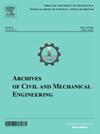Interactive effects of \({\text{TiB}}_{{\text{w}}}\) distribution and temperature on the mechanical properties of in-situ \({\text{TiB}}_{{\text{w}}} {\text{/TC4}}\) composites
Abstract
Network structured titanium matrix composites exhibit significantly enhanced mechanical properties compared to the base titanium alloy. However, the existing research on the composites is mostly conducted at room temperature. Studying the interactive effects of reinforcement distribution and temperature on the mechanical properties of the composites is of great importance for material applications. This paper fabricated in-situ \({\text{TiB}}_{{\text{w}}} {\text{/Ti6Al4V(TC4)}}\) composites with different distribution of TiB through fast hot-pressing sintering. Tensile experiments at different temperatures were conducted to elucidate the interactive effects of TiB distribution and temperature on the mechanical properties of the composites. The influence of network size on the mechanical performance of network-structured composites was also analyzed. Additionally, room temperature in-situ tensile tests were performed on the composites with homogeneous and network-distributed TiB. The fracture mechanisms of the composites with different distributions of TiB were revealed by examining the fractography. The results showed that the composites with a homogeneous distribution of TiB exhibit brittleness at low temperatures, yet they demonstrate superior mechanical properties at high temperatures compared to those with network-distributed TiB. The small network structured composites have stronger grain refinement and higher TiB load-bearing efficiency and have better mechanical properties than the large network structured composites. At low temperature, the fractography shows that the network-distributed TiB can promote crack deflection and increase the fracture strain of the composites. However, at high temperature, the fracture modes of the composites with different distribution of TiB are similar due to the softening of the matrix.

 求助内容:
求助内容: 应助结果提醒方式:
应助结果提醒方式:


